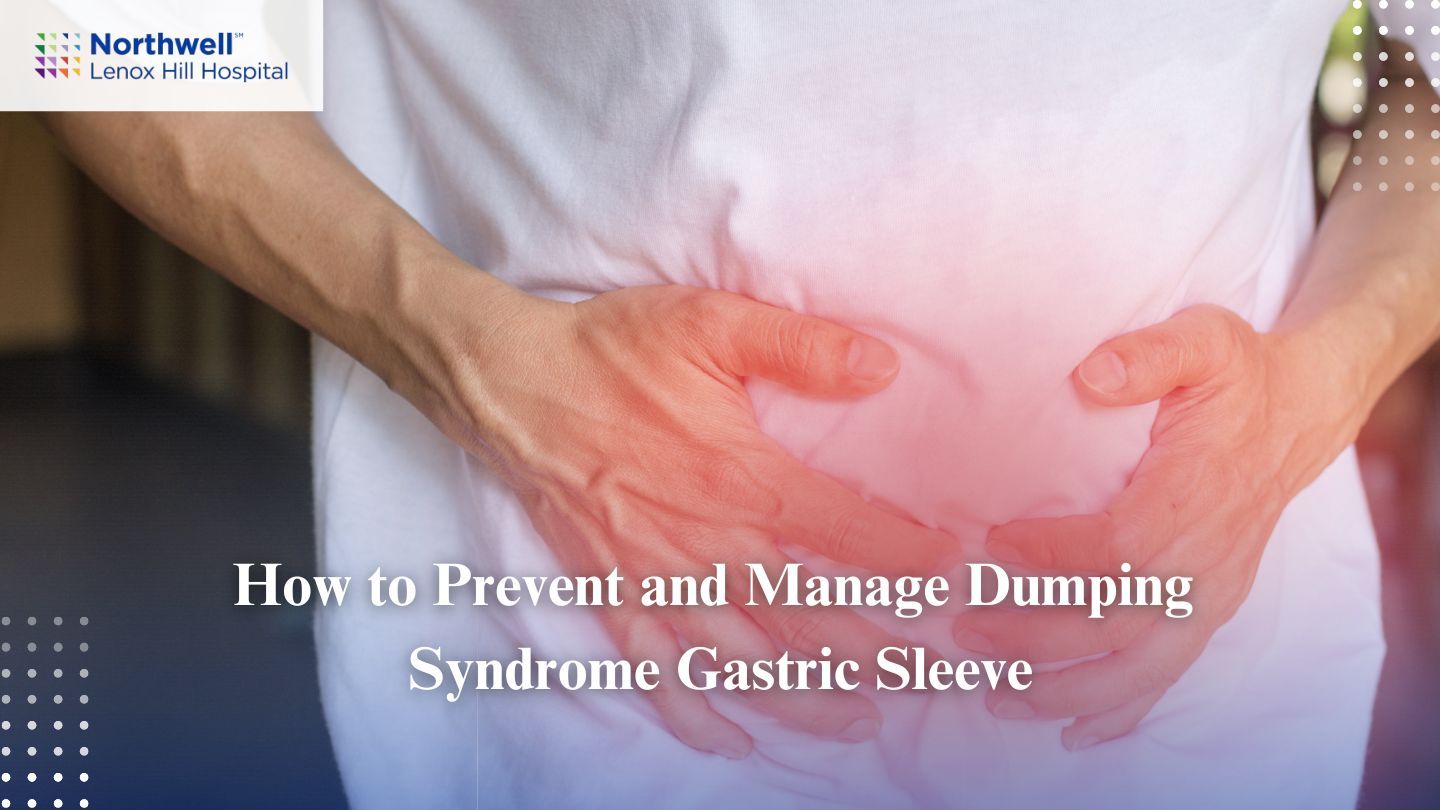
How to Prevent and Manage Dumping Syndrome Gastric Sleeve
Weight loss surgery, particularly gastric sleeve surgery, can lead to dumping syndrome, causing symptoms like nausea, diarrhea, and dizziness. In this blog, learn about its symptoms, causes, and management strategies to prevent and manage dumping syndrome.
Key Takeaways
Dumping Syndrome often occurs after gastric sleeve surgery, with early symptoms like nausea and late symptoms such as low blood sugar.
Managing it involves dietary changes, fluid timing, and lifestyle adjustments like regular exercise.
Prevention includes small, frequent meals and stress management to reduce symptom occurrence.
Monitoring with regular check-ups and symptom tracking is key to effective management.
What is Dumping Syndrome?

Dumping syndrome, also known as rapid gastric emptying, is a condition that occurs when food moves too quickly from the stomach to the small intestine. This rapid transit can lead to a range of uncomfortable symptoms, including nausea, vomiting, abdominal pain, diarrhea, and sweating. Dumping syndrome is commonly associated with gastric bypass surgery, a type of weight loss surgery that involves creating a small stomach pouch and re-routing the small intestine. This surgical alteration can disrupt the normal digestive process, leading to the swift movement of food and the onset of symptoms.
Causes of Dumping Syndrome After Gastric Sleeve and Gastric Bypass Surgery
Dumping Syndrome, also known as rapid gastric emptying, emerges due to hyperosmolar in the stomach’s functioning following weight loss surgery, such as sleeve gastrectomy. In this type of bariatric surgery, most of the stomach is surgically removed, creating a reduced-size stomach pouch. Consequently, hyperosmolar chyme may move too quickly into the small intestine because of these alterations.
Hormonal fluctuations after gastric surgery play a pivotal role in exacerbating Dumping Syndrome. Changes within gastrointestinal hormones post-operation can affect how well digestion functions and alter gut movement — all factors that intensify issues associated with rapid gastric emptying along with its related symptoms.
Risk Factors for Dumping Syndrome
Several factors can increase the risk of developing dumping syndrome after gastric bypass surgery. Understanding these risk factors can help in taking preventive measures:
- Type of Gastric Bypass Surgery: Certain types of surgery, such as Roux-en-Y gastric bypass, may be more likely to cause dumping syndrome than others.
- Size of the Stomach Pouch: A smaller stomach pouch can lead to quicker emptying of food into the small intestine, increasing the risk of dumping syndrome.
- Type of Food Eaten: Consuming high-sugar or high-fat foods can trigger dumping syndrome symptoms.
- Amount of Food Eaten: Eating large meals can overwhelm the reduced stomach capacity, leading to rapid gastric emptying.
- Other Health Conditions: Conditions such as diabetes or gastroparesis can exacerbate the risk of developing dumping syndrome.
By being aware of these risk factors, individuals can make informed choices to minimize their chances of experiencing dumping syndrome after gastric bypass surgery.
Symptoms of Early and Late Dumping Syndrome

Dumping Syndrome manifests as early and late symptoms. Healthcare professionals diagnose dumping syndrome based on patient-reported symptoms, the timing of these symptoms, and additional tests like glucose tolerance or hydrogen breath tests. Early symptoms occur 10-30 minutes after eating sugary foods, causing abdominal pain, diarrhea, nausea, fullness, and cramps, especially in those who’ve had weight loss surgery. Late symptoms appear 1-3 hours later due to low blood sugar, causing weakness, dizziness, sweating, and fainting. These symptoms range from mild to severe and can disrupt daily life. Recognizing their timing is key to managing them and aids in effective communication with healthcare providers for tailored treatments.
Diagnosing Dumping Syndrome
Diagnosing dumping syndrome typically involves a combination of medical history, physical examination, and diagnostic tests. Here’s how healthcare providers approach the diagnosis:
- Medical History: The doctor will ask detailed questions about the patient’s symptoms, medical history, and eating habits to identify patterns that suggest dumping syndrome.
- Physical Examination: A thorough physical examination will be conducted to check for signs such as abdominal tenderness or a rapid heartbeat, which are indicative of dumping syndrome.
- Diagnostic Tests: Tests like a glucose tolerance test or a hydrogen breath test may be ordered to confirm the diagnosis. These tests help in assessing how the body processes sugars and other nutrients.
- Dumping Symptom Rating Scale: The doctor may use a dumping symptom rating scale to evaluate the severity of the patient’s symptoms. This scale provides a structured way to monitor symptoms and track progress over time.
Accurate diagnosis is crucial for the effective management and treatment of dumping syndrome, ensuring that patients receive the appropriate care and interventions.
Managing Dumping Syndrome
To effectively manage dumping syndrome, a comprehensive strategy is essential, encompassing dietary alterations, guidance on fluid consumption, and modifications to one’s lifestyle. The objective of these measures is to mitigate the discomfort associated with the condition while improving life quality. These measures are particularly important for individuals who have undergone weight loss surgery, such as gastric sleeve surgery.
In addition to these strategies, the use of dietary supplements can be crucial in managing nutritional deficiencies associated with dumping syndrome.
As an initial step in treatment, adjustments to diet are usually recommended. Such adaptations involve partaking in smaller meals more frequently throughout the day while steering clear of simple sugars and refined carbs. Keeping track of fluid intake and its scheduling, along with engaging in consistent physical exercise and employing stress reduction methods, can contribute notably to symptom control.
Dietary Adjustments
Managing dumping syndrome often entails making essential dietary changes. Consuming frequent smaller meals rather than three large ones throughout the day is a key tactic in preventing symptoms by slowing gastric emptying. Splitting your food intake into six modest portions, for instance, can alleviate some of the discomfort linked to this condition. These dietary changes are crucial for individuals who have undergone weight loss surgery to prevent symptoms of dumping syndrome.
It’s imperative to steer clear of foods that are rich in simple sugars and refined carbs because they exacerbate symptoms. Cutting down on sweet treats can help minimize instances of hypoglycemia after meals. It’s wise to be circumspect about dairy products as these have been known to provoke dumping syndrome in certain people.
Introducing new food items slowly and carefully monitoring how one’s body reacts enables patients to pinpoint their particular triggers better. It might become evident that specific foods such as bread or tough meats lead to issues. Choosing more digestible options like softened foods or toasted bread could be beneficial for easier digestion and symptom management.
Fluid Intake Recommendations
Maintaining adequate hydration is crucial, with individuals needing to drink between 64 and 96 ounces of fluid each day. Fluid loss can exacerbate symptoms of dumping syndrome, making proper hydration essential. To avoid rapid gastric emptying that can exacerbate symptoms, it’s important not to drink any liquid until at least 30 minutes after consuming a meal. Proper hydration is especially important for individuals who have undergone weight loss surgery to manage symptoms of dumping syndrome.
To minimize discomfort and alleviate symptoms, fluid consumption should be carefully timed and separated from meals. Ensuring there’s sufficient time between eating solids and drinking liquids aids in symptom management while also ensuring proper levels of hydration are met.
Lifestyle Modifications
Modifying one’s lifestyle plays a significant role as well. Engaging in consistent physical activity such as walking, swimming, or cycling can enhance digestion and help stabilize blood sugar levels, which is vital for individuals managing health concerns related to digestive and kidney diseases. These lifestyle modifications are particularly beneficial for individuals who have undergone weight loss surgery to manage symptoms of dumping syndrome.
Employing stress management strategies, including meditation, yoga, or deep breathing exercises, can lessen the impact of symptoms. Since enduring stress has the potential to exacerbate dumping syndrome conditions, integrating methods aimed at reducing stress into daily life routines proves advantageous.
Adhering to regular sleeping patterns and cultivating a balanced way of living are key factors in controlling dumping syndrome. Obtaining sufficient rest paired with maintaining healthy day-to-day habits contributes substantially to overall health maintenance and alleviation of symptoms associated with this condition.
Treatment Options for Dumping Syndrome

Treating dumping syndrome involves a multifaceted approach that includes lifestyle changes, dietary modifications, and sometimes medical interventions. Here are the primary treatment options:
- Dietary Changes: Patients are often advised to eat smaller, more frequent meals and avoid high-sugar or high-fat foods. Increasing fiber intake can also help slow down gastric emptying and reduce symptoms.
- Medications: Doctors may prescribe medications such as anti-diarrheal drugs or medications that slow gastric emptying to help manage symptoms.
- Behavioral Therapy: Cognitive-behavioral therapy can be beneficial for managing stress and anxiety related to eating, which can exacerbate dumping syndrome symptoms.
- Surgery: In severe cases, surgical intervention may be necessary. This could involve revising the gastric bypass surgery or performing a new procedure to slow gastric emptying.
It’s important to note that dumping syndrome can be a serious condition, and seeking medical attention is essential if symptoms persist or worsen over time. With the right treatment plan, individuals can manage their symptoms effectively and improve their quality of life.
Preventing Dumping Syndrome
It’s essential for individuals who have had gastric sleeve surgery to guard against dumping syndrome, as it can profoundly affect their well-being and daily life. Preventive measures are crucial for individuals who have undergone weight loss surgery to avoid the onset of dumping syndrome. Engaging in consistent exercise is beneficial not only for mitigating the intensity of symptoms but also for enhancing overall health. Physical activity supports digestive processes and helps maintain stable blood sugar levels, minimizing instances of low blood sugar.
Employing stress reduction strategies like mindfulness or yoga plays a significant role in managing the manifestations of dumping syndrome. Adopting such techniques aids in achieving a harmonious lifestyle while warding off the occurrence of symptoms.
By concentrating on regular physical exertion and effective management of stress, one can considerably lessen the likelihood of experiencing dumping syndrome after undergoing gastric sleeve surgery. Making these practices an integral part of one’s everyday regimen paves the way to a healthier existence following surgery, marked by greater comfort and improved quality-of-life outcomes.
Monitoring and Follow-Up
Effective management of dumping syndrome necessitates regular monitoring and follow-up. This includes regular blood tests to keep track of blood sugar levels, electrolyte balances, and potential nutritional deficiencies. These tests are crucial for diagnosing and managing the condition effectively.
Using a dumping symptom rating scale can also be beneficial. This scale helps individuals and healthcare providers monitor the severity of symptoms and track progress over time. It provides a structured way to assess how well the management strategies are working and make necessary adjustments.
Follow-up appointments with healthcare providers are essential. These appointments allow for ongoing assessment and modification of treatment plans as needed. They provide an opportunity to discuss any new symptoms, review dietary and lifestyle changes, and ensure that the management plan is effective. By staying vigilant and proactive, individuals can significantly reduce the risk of complications and improve their overall health and well-being.
Summary
In conclusion, preventing and managing dumping syndrome after gastric sleeve surgery requires a combination of dietary changes, lifestyle modifications, and regular monitoring. By staying proactive with symptom tracking, stress management, and medical follow-ups, individuals can effectively control their symptoms and enhance their quality of life post-surgery.
With years of experience, our program is dedicated to providing innovative, personalized care tailored to each patient’s needs. If you’re considering weight loss surgery in NYC, trust us to guide you every step of the way. Contact Lenox Hill Bariatric Surgery Program today to learn more about our comprehensive support and how we can help you achieve lasting health and wellness.